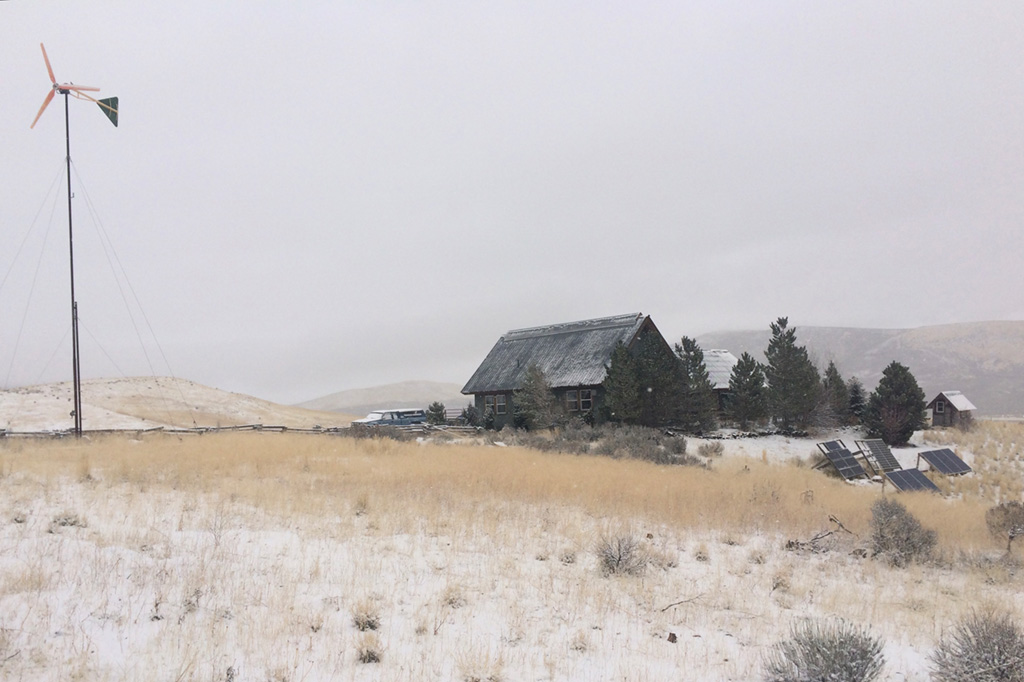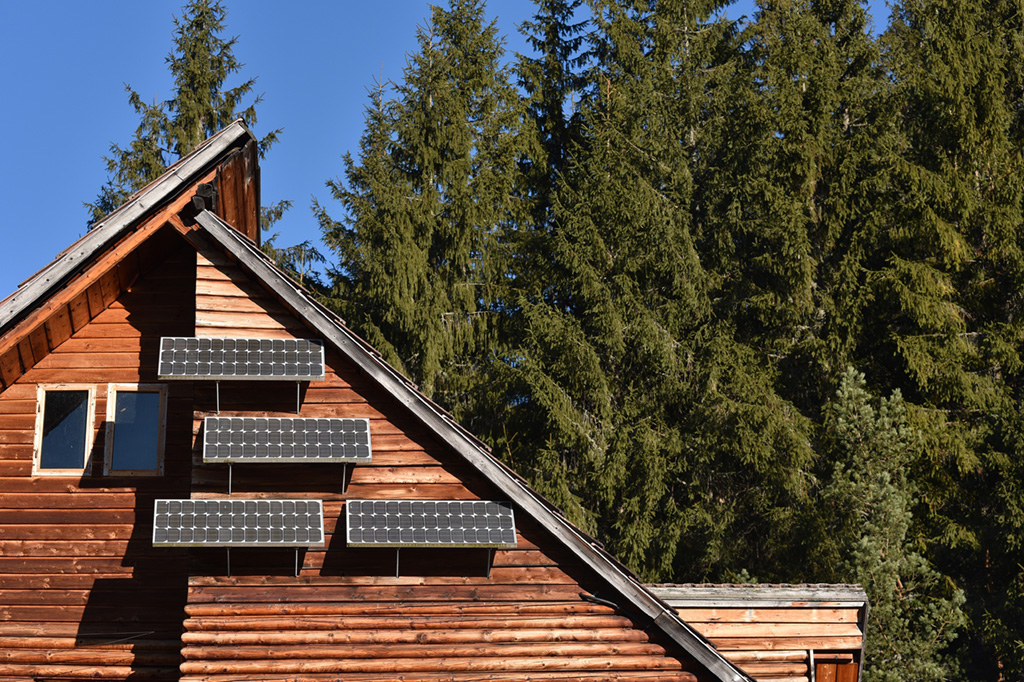Held at gunpoint by a SWAT team, Ellen Nasvik and Jason Dykhouse were ordered to the floor of a Minneapolis Kinkos. SWAT was looking for a gunman. The newlyweds were making thank-you notes. They had just returned from their Idaho honeymoon. That was nearly 25 years ago. The alleged gunman was never found, and for Nasvik and Dykhouse, it was a traumatic last straw. They ditched the city for a slapdash structure with no electricity, by Timmerman Hill, one built from salvaged materials left behind after the Richfield canal construction.
“What were we thinking? We were dreamers from Minnesota,” said Nasvik. She has an uncle who helped make Blaine County feel like home. “Neither of us had thought any of this through. When the wind really blew, it blew straight through the house.”
Nasvik and Dykhouse have good jobs (Spanish immersion teacher and bicycle shop manager). They found a place where, day to day, people are simply friendlier, and they went to work making their off-grid home homier.
“Our well is 300 feet deep and the water table is good and consistent. We didn’t know it at the time. We really got lucky there.”
Their property has a good septic system, too, another stroke of luck, but, on a tight budget, DIY is forever. As the crow flies, the house they bought for $50,000, owner financed, is about a mile and a half from a powerline. To get to the highway, it’s 3.5 miles on a dirt driveway and marginal county road. The estimate from Idaho Power to run an extension line to the house was about $90,000, so Nasvik and Dykhouse found a used solar array and four batteries to power lights and the pump. They began with propane for cooking and refrigeration, and wood heat. A company in Montana helped them figure out the solar.
“We spent the day with them and basically got the information we would need to wire our house,” Nasvik said. They still use the original Xantrex current inverter, but they’re about to buy their next round of batteries for about $2,800.

Ellen Nasvik and Jason Dykhouse bought this home near Timmerman Hill and installed their own solar electric system. Idaho Power’s estimate to bring an extension power line to them was $90,000.
There is no clear data on the number of off-grid users in Idaho, but Scott Gates, the lead engineer for Idaho Power’s net metering program, said the utility built about 50 off-grid systems in the 1990s. Today, the utility has 1,200 net metering customers, an arrangement for those who produce their own power, but also feed excess into the grid for credit, which is redeemable when they need utility power. Interest in the program is increasing, and for a myriad of reasons, Gates said. Some customers are trying to do the right thing by seeking clean energy. Others are hedging against future electricity costs.
Today, a bigger detraction for many who think about the impact of utility power production is that even though it’s located out of state, nearly a quarter of Idaho Power’s electricity is generated from coal. Another 10 to 20 percent comes from natural gas and other fossil fuels. Some people are even wrestling with the efficacy of receiving the lion’s share of the state’s power, about 39 percent, from dammed rivers.
Sun Valley Institute thinkers advocate for a community that takes a holistic view of the human impact on the environment and pushes for a Blaine County future where 100 percent of energy demand is covered by green sources. Renewable energy credits, electric cars and zero emissions energy are subjects at cocktail parties where conversation often spins to how best to solarize Sun Valley, said Billy Mann, a software engineer who’s long been in the local solar business.
Aimée Christensen, executive director of the institute, advocates for local resilience with local food and local energy—even a micro grid with battery storage—essentially isolated from the rest of the world.
Gates said if all aspects of net metering were online at the same time, meaning all interconnected solar panels were in the sun and all windmills were spinning, interconnected customers would be contributing about 10 megawatts to the grid. At peak production, Idaho Power can kick out 3,594 megawatts, so net metering is a tiny portion of production today. To put things in perspective another way, near the city of Salmon, Idaho Power operates two diesel generators using locomotive technology installed in 1967 that put out five megawatts, so it is unlikely, without a major boom in adoption of renewable power generation technology, that net metering or off-grid living will cause the utility to scrub out-of-state coal power production anytime soon.
Off-grid equipment vendors are also seeing business pick up with increased demand for renewable energy, but grid-dependent customers dominate the market. The convenience of electric power is still very new, however, and change is the only constant when it comes to energy transfer. It has only been 130 years since Hailey employed a plant for electric lights, the first municipal use of electricity in the Idaho Territory. The modern grid didn’t exist for decades more. For properties missed by rural electrification programs that helped to expand the grid, the cost of linking in today is sometimes prohibitive, as Nasvik and Dykhouse discovered.
Those going off grid can be found across the financial spectrum, from boot strap to deep pockets. Ed Van Every, a master electrician who got his start in the 1960s as an apprentice with Sun Valley Company, has worked on many off-grid systems and was, until his recent semi-retirement from Roberts Electric, certified for such work in five states. He spends winters with his wife in Munich, Germany.
“I went to work at Sun Valley when they converted from steam heat to electric heat. I apprenticed and then kept doing it,” Van Every said while fixing an electrical issue during the sale of a multi-million-dollar Ketchum house that was about to close. “You want to see solar? Go to Germany. Germany has 15 percent of the world’s sunlight, but 85 percent of the world’s solar.”
When not in Germany, Van Every spends his Sun Valley months serving Idaho clients, many with discretionary income, who are producing off-grid power, some because they know about battery power used on their yachts. For many years, Van Every was the resort’s lead electrician where he learned from “an extraordinary journeyman” who got his start in the Navy where power systems, like solar, begin with conversion of direct current to power radios, so he was primed for off-the-grid work. He recalls the ship-like bank of lead-acid batteries that ran the resort’s telephone system when the power was out. Some off-grid systems are simply that, backup when utility service goes down.
Van Every said a challenge to the upkeep and upgrades of off-grid systems is finding apprentices who want to follow in his shoes.
Mann councils people to go the net metering route if they can. “Just battery-based systems—the cost now is too prohibitive. Honestly, you gotta wait. I don’t want people buying now. We’ve seen panel pricing drop. The same is coming with batteries.”
The Tesla Powerwall (a lithium-ion battery system for home energy storage) is in a nice package and mass production will drive down the installation cost, Van Every said, but it’s not designed for the backcountry application. The lead-acid battery is still the best solution off grid.
Mann said lithium-ion batteries are still being designed to be connected to the grid, adding that the Tesla benefit is that it’s easier to use, safer than other lithium-ion batteries and will come with a 15-year warranty. “It will have more output and capacity and the cost is going to come down like crazy over the next couple of years.”
Nasvik said she wishes her family’s batteries could hold out a little longer or that off-grid technology was further along, but the time for replacement has come. Through a trade, the family has a windmill, but it pumps out more power than anyone expected. Unlike solar arrays that are unaffected once batteries are fully charged, a windmill must be hooked up to something like the grid to absorb the energy it produces or it will eventually break apart in a windy place unless it has a brake on it. It’s a problem
Nasvik and Dykhouse are still brainstorming.
“A lot of the problems could be solved with money. You can hire a primo setup to come in and build a system,” said Nasvik, who still considers herself an amateur of off-grid living. “We’re really miserly with electricity. We have a small TV, and we’re thankful to the Chinese for overproducing, but we never call the guy.”
Lighting the backcountry and connecting Idaho electricity users to the grid has always been a challenge. Power outages are a simple reason some people seek backup power with solar-charged battery banks or traditional fuel generators. But wildfires are one of the toughest interruptions to correct when powerlines burn down. Idaho Power estimates that it spends about 8 percent of the cost of infrastructure maintaining it.
“So far, we’ve been lucky this year,” said utility spokesman Brad Bowlin. “Sometimes with wildfires the costs skyrocket.”
Nasvik said her family’s home has survived three wildfires. Once, a fire came so quickly she didn’t have time to hitch up the trailer for the horses. She held their bridles through the window of the car as she evacuated with her sons. The younger one was still an infant. A tanker plane dumped retardant around the house. The horses were caked in pink.
“I don’t know how they kept it together,” Nasvik said, explaining that she never felt as alone as she did sitting in the car with her small children, holding the reins of the horses, and wondering if the house had burned down. “There was a donut around the house where the fire stopped.”
The land was scorched. The road was a mess. Idaho’s harsh conditions regularly make the commute difficult with deep snow or slippery mud.
“In my mind, the road has been a much bigger issue than the electricity,” Nasvik said. “Last year was really crazy with all the snow.”


